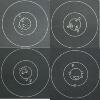Dr T
Member
What makes them accurate?
What makes them fast?
What makes them fast?

I know polygonal rifling generally is, but I don't know about 5R.Isn't this more common outside of North America?

Isn't this more common outside of North America?
I know polygonal rifling generally is, but I don't know about 5R.
Almost all the discussion about barrels ignore the intrinsic accuracy of bullets. The assumption is that bullets are all perfect and that the different barrel types are the difference on target. I do not believe this at all, and I am going to claim this is the reason for all the differing opinions. Bullets are a confounding factor.
In a rare excursion into rifled barrels by shotgunner Don Zutz, he said a prewar Model 70 was as accurate as a new rifle, given fresh bullets. This back in the 20th century, likely barrels and bedding are better now.


I used Jim’s link and spec’ed a Savage 12 26” featherweight polygon rifled barrel in a seven twist and fluted for $783.67. It said six grooves, so it’s a hexagon I fathom. I won’t know for sure, that’s too much for me.I'd like to see high quality polygonally - rifled barrels available locally
Isn't this more common outside of North America?
Let’s not get too crazy. I hear they just broke a cutting button and forced it into a smaller bore to use it anyway. The missing groove and rifling shape is just the “happy coincidence” result.We copied it from the Russians. For once they may legitimately claim credit for inventing something.

We copied it from the Russians. For once they may legitimately claim credit for inventing something.
They all could have just gone back to some turn of the century British rifles where it was known as "trough shaped rifling."
We copied it from the Russians. For once they may legitimately claim credit for inventing something.
I read a couple of years ago Steyr when hammer forging a barrel did the chamber and barrel in one shot resulting in perfect alignmentWar time barrels may shoot well, my two groove Lee Enfield
View attachment 1104860
shoots cast bullets more accurately than my five groove Lee Enfield.
View attachment 1104861
I don't have a pristine M1917 to prove anything about 5 groove barrels
View attachment 1104862
There was a pre WW1 period where shooters with Krag's were using cast bullets, but pretty much after that, cast bullets were replaced with jacketed. Military rifles were not made to be target rifles, and war time production barrels, two groove, four groove, and five groove, were made under "get it out the door" conditions. If it went bang, that was good enough in a war where 60,000 men a mouth were being removed from the battlefield, and the replacements needed thunder sticks. It was worse for the Russians, there were times at Stalingrad were the average expected lifetime of a Russian solider was 24 hours.
Almost all the discussion about barrels ignore the intrinsic accuracy of bullets. The assumption is that bullets are all perfect and that the different barrel types are the difference on target. I do not believe this at all, and I am going to claim this is the reason for all the differing opinions. Bullets are a confounding factor. They are not all of the same weight, the jackets vary in thickness, and the distribution of lead cores vary enough that the center of gravity varies between bullets of the same lot. All of the variables create inaccuracy. I can say, different bullets shoot wildly different, in the same tube. Therefore I don't know of any reasonable test that can be funded on a hobbyists income, to prove that one rifling configuration is inherently better than any other.
All we as shooters can do is buy barrels by reputation. You can talk to the barrel makers, ask the right questions about surface finish, bore dimensions, bore concentricity, and decide for yourself if you want the tube. One barrel maker told me barrel making techniques have a learning curve, and the different techniques, be they cut rifling, button rifling, broach rifling, all have their unique problems, but once mastered, a good barrel can be made from any. And don't forget a chambering is important, a bad chambering job with an oval chamber will not give best accuracy no matter how good the blank. And another issue, the firing pin should be hitting the center of the primer, off set firing pin hits create inconsistent ignition, and no matter how good the blank, if ignition is not consistent, accuracy will not be either.
I am getting to be of the opinion that a barrel choke is a good thing. I have a Benchmark 22lr where the maker deliberately created a choke, and of all things, I have a 1937 M70 that clearly has a choke at the muzzle. The patch tightens up as it approaches the muzzle. Both of these barrels are exceptionally accurate. There might be something to tight barrels being more accurate, all things being equal.
